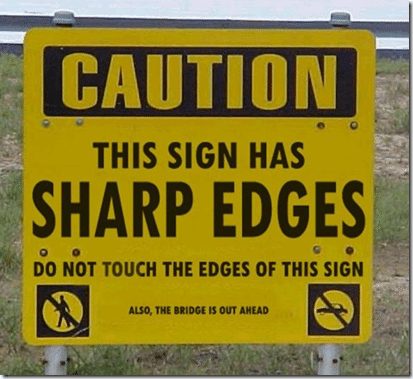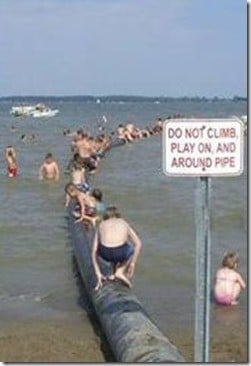Why Do We Ignore Safety and Warning Signs – Sometimes With Tragic Results?
 We have all seen and had a chuckle at “Caution This Sign Has Sharp Edges” with the very fine print: “also, the bridge is out ahead”. We have devoted a whole page to stupid and pointless signs, the semiotics of which imply that everybody is stupid except, of course, the person who posted it. See This Toaster Is Hot.
We have all seen and had a chuckle at “Caution This Sign Has Sharp Edges” with the very fine print: “also, the bridge is out ahead”. We have devoted a whole page to stupid and pointless signs, the semiotics of which imply that everybody is stupid except, of course, the person who posted it. See This Toaster Is Hot.
Last week, Brisbane QLD was hit by a “severe and dangerous storm”. Brisbane had more rainfall that day than any other May day on record. My suburb received over 200mm (8 inches) of rain in an hour. One of our blog authors, Rob Sams, had a similar experience with storms in his town last week (see Am I Stupid I didnt think of that).
Anyway, I had been watching the weather reports all day and listening to the warnings from the QLD Premier and others who harped on about staying indoors, being prepared and, whatever I do, don’t drive through flood waters! My son was due to return to school from a camp and I knew he would be cold, wet, dirty, tired, hungry and loaded up with all the gear I made him take (yeah I wanted him to be prepared – lol). Due to the weather, the threat to cancel public transport and having all the stuff to carry I decided to pick him up from school, leaving a bit earlier than usual as I knew the traffic would be bad. I live in a semi-rural area and as I approached one of many creek crossings en route to school I could see that the creek had risen dramatically and was flowing quite quickly across the road. Second thoughts entered my mind but my overriding thought was that of getting to my son, so I gunned it and powered through like I had seen others in front of me do. I had a scary moment as a truck, coming the other way, kicked up a wake and I felt my car lift and shift sideways. I successfully negotiated several other flooded sections before I got to school and found my little drowned rat!
By the time he had consumed $30 worth of KFC we heard that all of the roads back to our house had been closed by the authorities, even ambulances were being used to block roads and divert traffic. We just had to wait it out…… After a couple of hours we heard on the radio that someone had drowned after trying to drive across a flooded road – it was at the very same spot that I had first driven through at the start of my journey! Within minutes there were 4 more drownings reported, again cars crossing flooded roads and also less than 10 minutes from where I live! It was alleged, but not yet proven, that the roads had been closed and warning signs had been posted. In one incident there were two 4WDs (SUVs) involved – one followed the other in but they didn’t know each other.
We got home 6 hours later, I jumped online to get an update. As expected, the social media trolls, safety crusaders (with their 20/20 hindsight vision) and frustrated authorities were damming the actions of people driving through flooded roads – calling them stupid, lacking common sense, putting lives at risk, why don’t they listen. Having just done what I did, it angered me to hear them judge others like this, particularly since they weren’t there. I sure as hell was reflecting and judging my own actions big time at that point but how do they know they wouldn’t have done the same thing in the same circumstances.
So why do people ignore warnings, disregard warning signs and act in a way that some may consider stupid?
I am a big proponent of Risk Homeostasis Theory. This theory was proposed by Gerald Wilde in 1983. It says that everybody has their own level of acceptable or ‘target risk’. If they subjectively perceive that risks are lower than their target risk then they will take additional risks in order to reap the benefits and rewards from doing so. If the subjective perceptions of risk are higher than their target risk then they will behave more safely in order to avoid any subsequent losses. Most of these judgements and risk perceptions take place unconsciously.
In his book, Target Risk 3 (Download a Free Copy Here), Wilde covers the ineffectiveness of warning signage in some detail. (p82)
A warning that is not perceived as needed will not be heeded – even when it is needed.
 Wilde says that warning signage can only make people behave more cautiously if they agree that their behaviour would probably be more risky if they had not seen the warning sign. Similarly, a warning sign can increase danger when it overstates the danger – meaning we take less precautions if our experience and subjective perception is that the danger is usually less than stated on the sign. If there are other benefits of ignoring the sign (like getting to home, school or work quicker) and if we have seen others ignore them without consequence (cross the flooded road) – then guess what happens?
Wilde says that warning signage can only make people behave more cautiously if they agree that their behaviour would probably be more risky if they had not seen the warning sign. Similarly, a warning sign can increase danger when it overstates the danger – meaning we take less precautions if our experience and subjective perception is that the danger is usually less than stated on the sign. If there are other benefits of ignoring the sign (like getting to home, school or work quicker) and if we have seen others ignore them without consequence (cross the flooded road) – then guess what happens?
Take a look at the sign in the photo on the left – what else but this behaviour would you expect?
We have all seen and been frustrated by road works signs that warn us to slow down but then we see no actual work taking place – what happens next time we see such a sign? A case of the “boy who cried wolf”?
Traffic lights, Giveway, and Stop signs on intersections have not been shown to increase the safety of these intersections to any great extent. Motorists have been “lulled into a false sense of safety” – thinking that everybody will obey the lights or sign and so they take no precautions or asses the potential threats and just proceed thru these intersections, oblivious to others.
Wilde agrees with my experience in the workplace and public areas that the main purpose of warning signage is to decrease the liability of those who erect them – “we told you so”. Many compensate for the difficulties in identifying hazards and predicting behaviours by “warning signage over-kill”. The only affect this has, when those hazards are minor or non existent, is to desensitize people, therefore negating any safety benefit.
Warning signage normally does not alter the frequency or size of the risk and has little or no lasting effect upon safety, regardless of whether the installation alters the external risk or threat. Wilde reports on a Finnish study of successful road warning signs which were only displayed when the risk was real and they were actually needed.
However, in the case of “road closed due to flood” signs, the risk was real and they only come out when needed – why don’t they work? Risk Homeostasis – people just want to get home, get fed, get dry, pick up family or even have a little bit of adventure – those are the benefits. Have most people ever been washed off a flooded road before? – no that only happens to idiots – how many times have you heard “I’ve got a 4WD (SUV)”, how many people did they see successfully do it in front of them, how often have we seen cars driving through flooded streets on TV? Obviously the perceived benefits outweigh the perceived risks. Would anybody who had a bad experience with flood waters last week or last year ever do it again? Not likely, but obviously it wasn’t the telling and warning signage that changed their perception – it was the experience – we make mistakes – we learn about risk.
After 6 hours of waiting to try and get home, I have to admit that I was tempted to drive through a flooded road again! This morning my car is in for repair – looks like $1600 for a new A/C compressor slightly damaged by water! Sighhhh, we make mistakes, we learn!


Do you have any thoughts? Please share them below